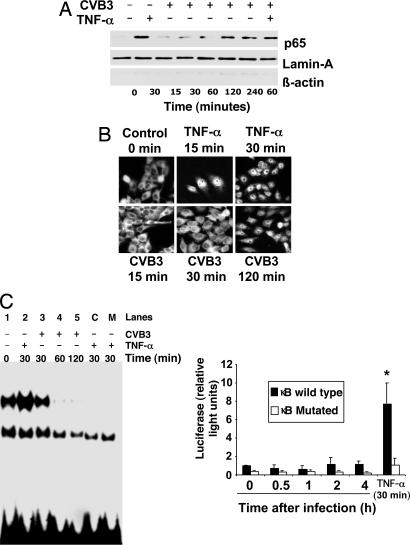Fig. 2.
NF-κB activation is impaired during viral infection. (A) HeLa cells were treated with TNF-α or infected with CVB3, and nuclear extracts were harvested and immunoblotted with antibody to p65, lamin-A, and β-actin. (B) HeLa cells treated with TNF-α or infected with CVB3 for 0–120 min were analyzed by immunocytofluorescence with antibody to p65. CVB3 induces delayed translocation of NF-κB into the nucleus after 120 min. (C) (Left) Nuclear extracts were isolated from HeLa cells infected with CVB3 at different time points or treated with TNF-α as before and subjected to EMSA assay with radiolabeled oligonucleotides containing the NF-κB DNA binding domain sequence. In addition, extracts from TNF-α treated cells were incubated with a 100-fold of unlabeled oligonucleotide (lane C) and with a scrambled oligonucleotide for the NF-κB binding sequence (lane M). (Right) HeLa cells were transfected with a WT or mutant κB element-luciferase reporter construct, and then infected with CVB3 for 0–4 h or treated with TNF-α for 30 min, and luciferase expression was measured by a luminometer (n = 3 ± SD; ∗, P < 0.05). Although NF-κB enters the nucleus, the NF-κB reporter gene is not expressed. (Magnification: B, ×40.)

